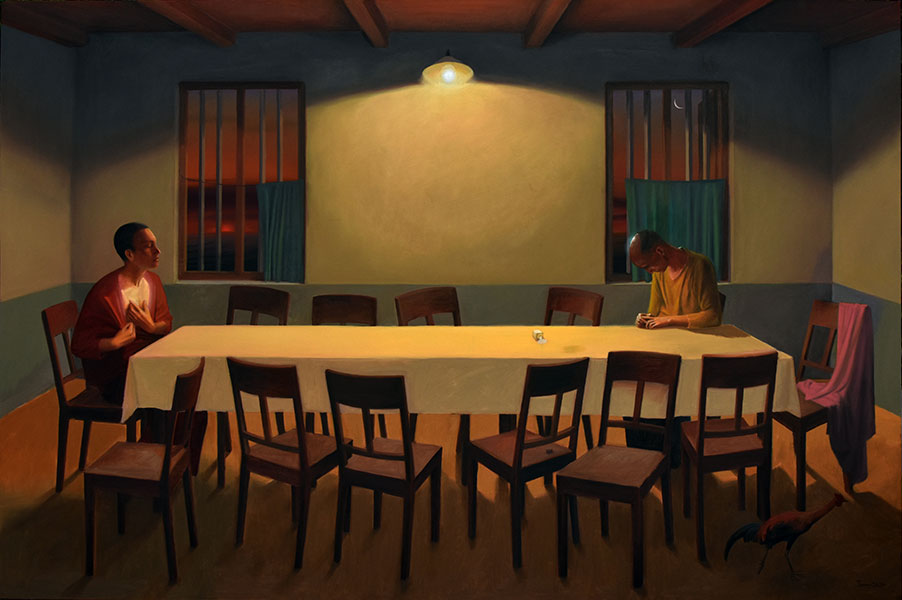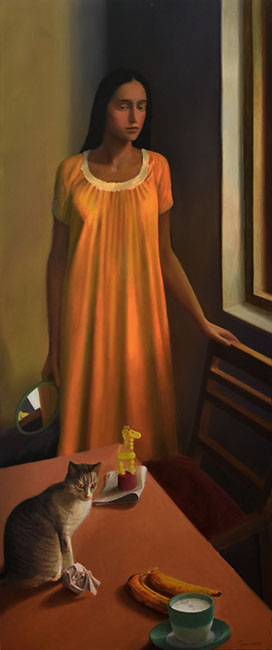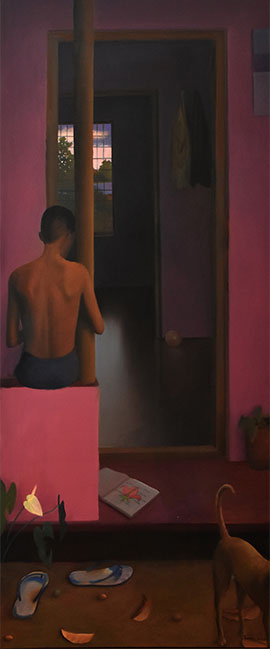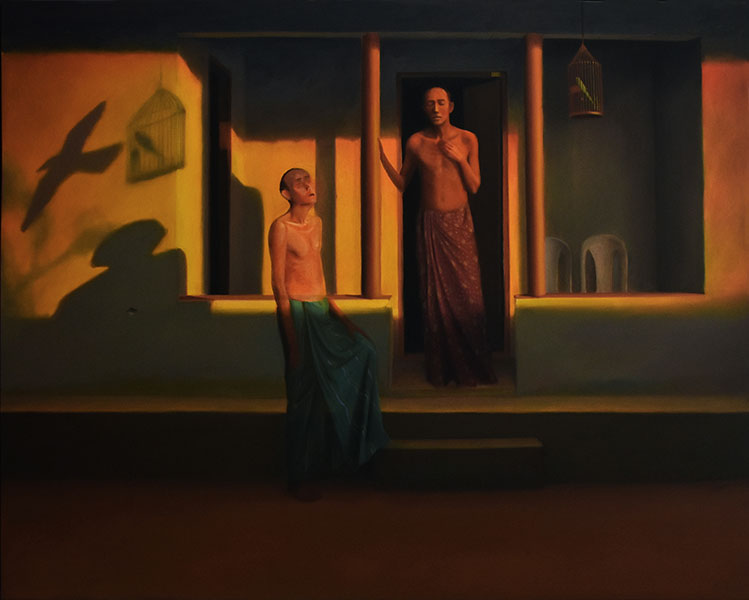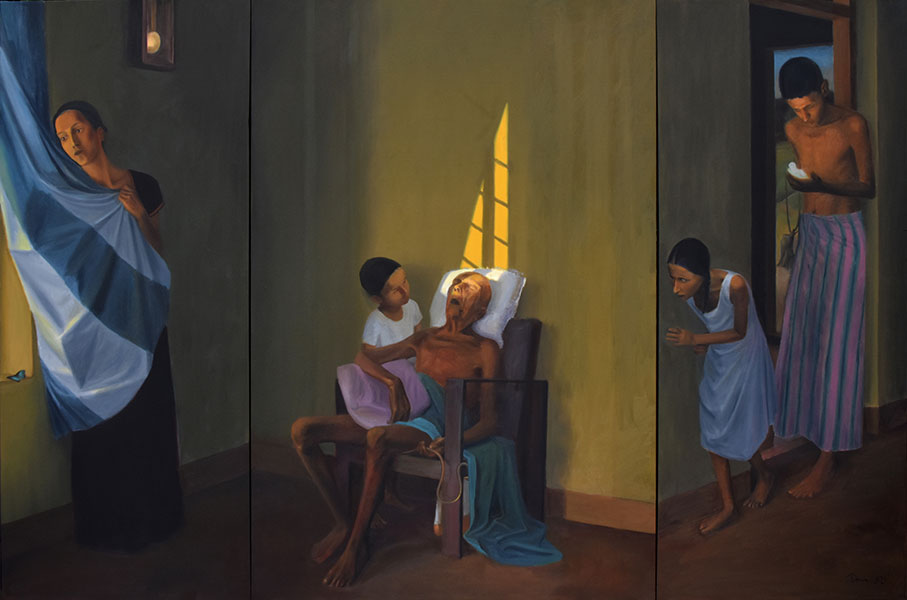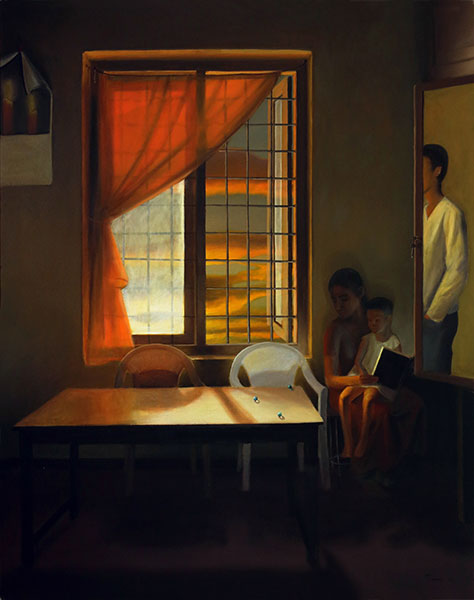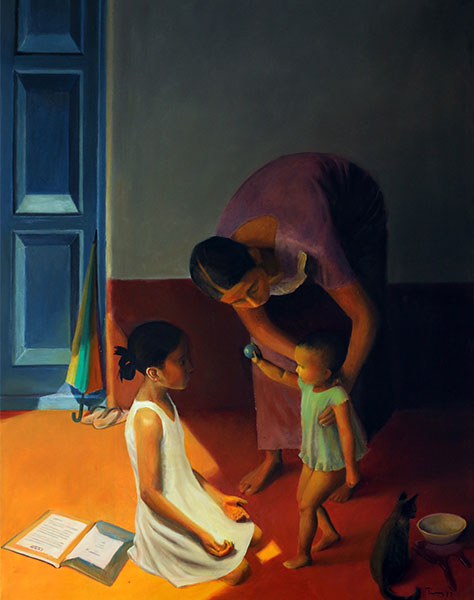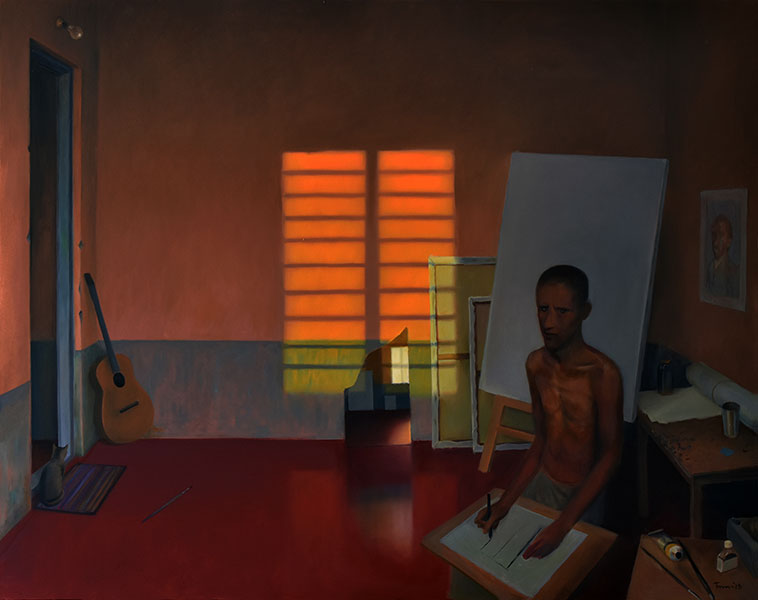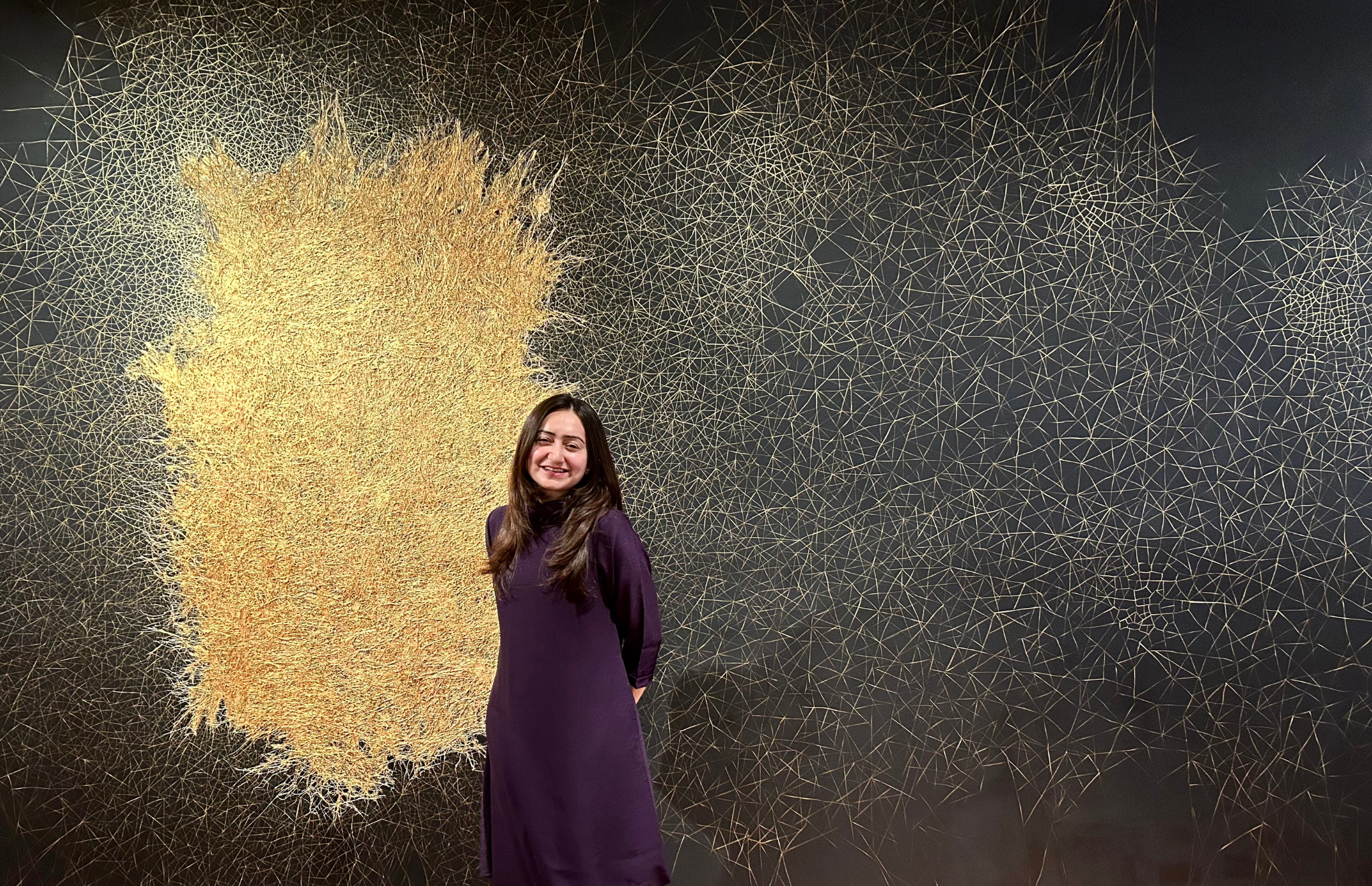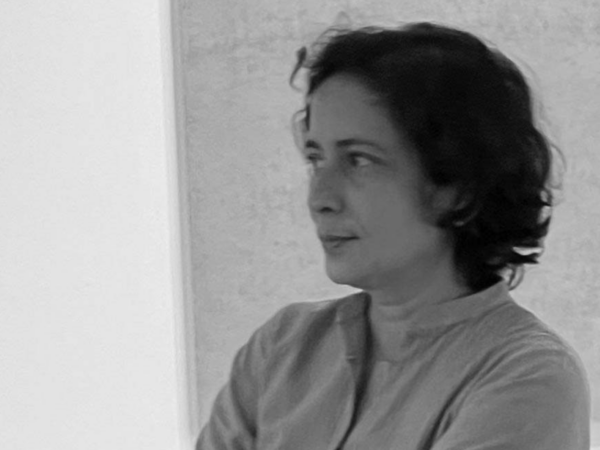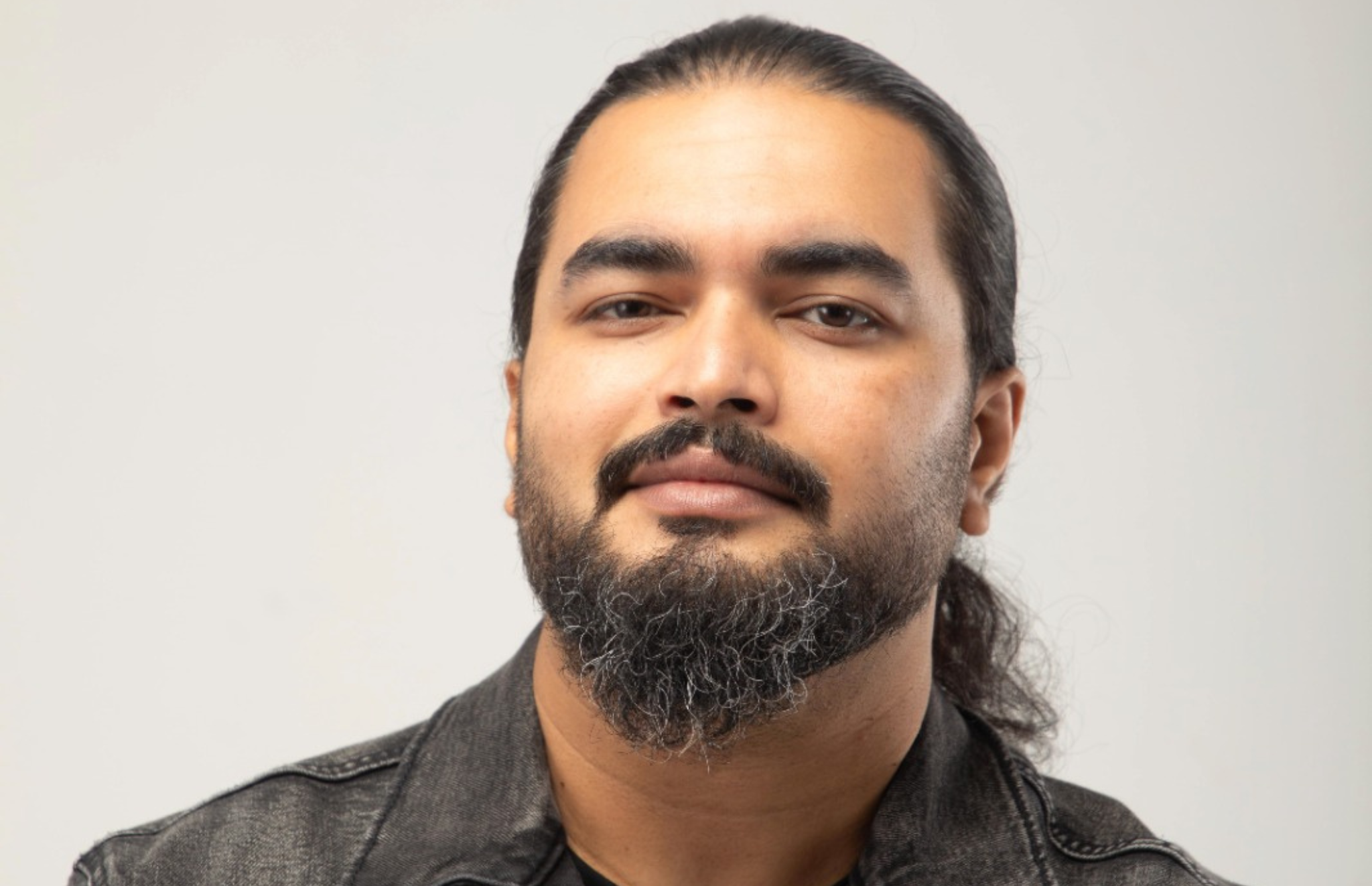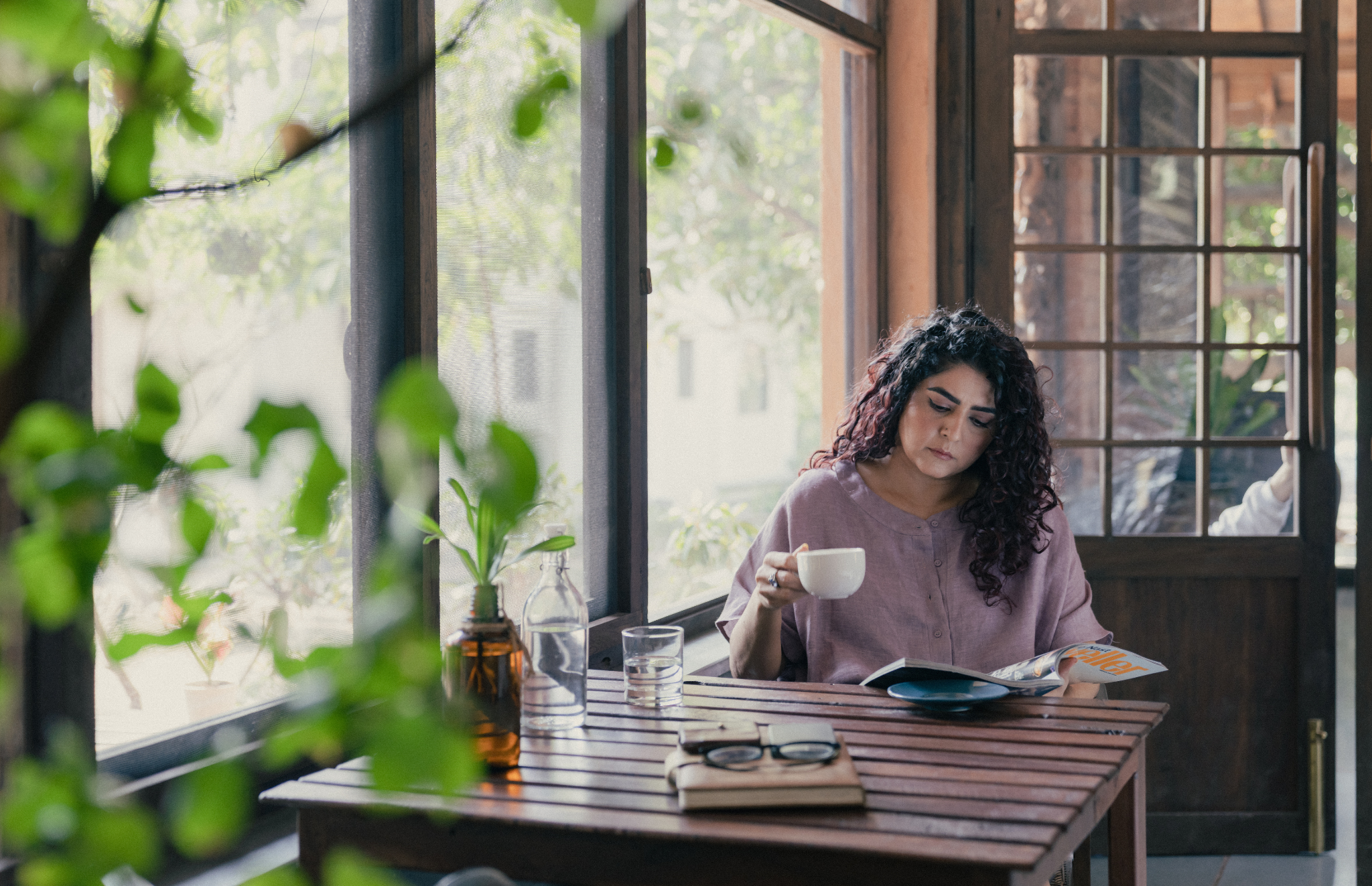Tom Vattakuzhy is an Indian painter born and brought up in Kerala. He pursued Bachelor in Fine Arts from Viswa Bharati University, Santiniketan in the year 1996 and continued his further studies by obtaining a Masters in Fine Arts from the Faculty of Fine Arts, MS University, Vadodara in 1998. The artist currently resides with his family in Kerala and continues to paint.
SP: Who/where do you draw your inspiration from?
TV: There is no specified or fixed source of inspiration for me. It can come any time from anywhere. I am not always consciously aware of where it actually comes from. However, nature, people, cinema, fiction, art, memories, lived experiences, current events and so on keep inspiring me in varying ways and levels. Certain sights, paintings, films or anything for that matter may give an initial spark for my works. Like a little girl collecting beads for stringing them into a necklace, I gather my inspirational bits from art and life around me.
SP: There seems to be a prominent presence of figures in your compositions. What is the significance of figures in your art practice?
TV: Human life and its existence have always been a concern for me. I believe my interest in painting figures comes out of that concern. When I say human figures, I do not mean portraits of any sort. Figures appear in my works as representations of people I grew up seeing from my younger age – the ordinary, the oppressive, the vulnerable and the marginalized who are destined to be in the outskirts of our political discourses. They dwell in the twilight zone between the truth and lie, propriety and impropriety; Good and evil and, real and surreal. I cannot think of art as art without a deep sense of love, compassion and concern for life and its predicaments. I feel that my works are a silent search for the meaning of life and its existence.
SP: Your colour palette has a close resemblance to that of Edward Hopper with the presence of theatrical light and shadow play. Do your works draw any inspiration from his paintings?
TV: I am a big fan of not only Edward Hopper but a great many artists. The list of them I love and admire with my whole heart grows longer and longer as days pass by. I do not see myself as an island separated or disconnected from the rest of the world and our historical past. My art and sensibility are formed with various influences. From the early Renaissance to the contemporary there are a great many artists who inspire me. All the artists my heart responded to have a place in shaping my artistic sensibility and I greatly owe to them.
I don’t think Hopper paintings have a direct influence in my works. But I feel connected to his works because of the similarity in the way of thinking and feeling. I admire his works as they have an inner life of their own. I think all the great art poses that quality. This is a thing beyond any kind of skill or technical proficiency. I am at loss for words to describe it. So I call it the soul. I think it is because of that quality we spend a long time before a work of art and feel glued to them. Hopper’s paintings, especially his later phase paintings appeal to me in that sense. True that the sense of solitude and the play of light and shadow in Hopper paintings can be seen as corresponding to my works also. But with my schema of things, the light is more than just light and the shadow is more than just shadow. I like to see it integrated with my visual language. With subtle tones of colour and light, I try to transform them into a different plane. The Colour palette is very important to me. Colour and its tonalities have a great role in bringing the emotional depth of the work.
SP: As a contemporary artist what is your take on the ever-changing contemporary art? What do you think is the future of Art?
TV: It is true that there are more diverse art practices today than ever before. The tendency of challenging or rebelling against the prevalent norms of art from the time of modernism onwards has given way to a wide spectrum of concerns and approaches to art practices today. We see artists working in diverse ways using different media for their expression. Words like Installation Art, Video Art, Experimental Art, Performance Art, Body Art, Dialogic Art, Process Art, Arte Povera and so on are somewhat familiar even among commoners today and have almost become another convention now. This crying quest for newness challenging the boundaries of art has now perhaps come to a stage where no more boundaries are left to be challenged. And it has democratized art to the level of ‘anything goes’ sort of affairs. This new wave of art as an idea has now banished even the concept of art as an aesthetic experience, perhaps, the last remnant that Modern art left behind. When I look at other art forms like music, dance or theatrics I don’t think such a situation prevails there. It is true that change is inevitable. Throughout history, it has happened in tandem with the changes in life and culture. But I don’t know where will this obsession for change take us to? I see the contemporary scene in a quite fluid state now where all kinds of art practices, old and new exist and remain prevalent. Only time can tell what will stay and what will be left behind as a fad.
SP: Your work has a strong impression of Balthus-like figures’ peculiar anatomy and expressions, dramatic presence of elements like mirrors/animals/insects/birds along with the human figures that are predominant in your works. Tell us something about the process of selection of these elements in your canvases.
TV: I grew up at a time when every household in my area had a range of domestic animals like cows, bulls, dogs, cats, chickens, ducks etc. People regarded them also as part of their life or an extension of their lives to nature. As Vaikom Muhammad Basheer, a well-known fiction writer from Kerala writes: they are ‘the inheritors of the Earth’. The earth, as I see it, is not of humans alone; it is extended to the other living things as well, hence they do exist in my works. The selection of these elements is often intuitive in sync with the narrative of the composition. They assume various roles- as symbols, similes or an allegory. With my working process, I go by feelings mostly. It may not have very clear contours as it occurs to me. I cherish it in my mind for days till I get clarity of vision and a strong urge to paint. Improvisations take place even after I set out to paint and it continues till I feel okay with the work. By saying okay, I mean a harmonious relationship with all the elements of the work – the inner and the outer, or the personal and the formal.
As for me, it is the personal element, in other words, the idiosyncratic and intuitive aspect of the work that mostly pulls me to a work. It often happens with me as an unspeakable feeling or emotion. If that gains more strength after fostering it in mind for days it will evolve into a painting. I find the formal elements such as colour, form, space, and light and shade etc. are also essential and of great interest, especially the use of light and light effects. I feel these aspects play a greater role in setting the tone of my compositions. So, what interests me or what I find more enticing and challenging is lending the work a satisfying result, a kind of unexplainable poetry, to the best of my abilities. I have often felt that art practice is like climbing mountains. When you start off, you may think that reaching its summit is the end of it. But it is only when you reach there you get to see another one, perhaps, greater than the one you climbed. Once you cover that there appears another one. Thus the journey continues, never finding its end.
SP: Painting in the age of AI, NFT, found objects and installation art where do you see your practice amongst these discourses today?
TV: First of all, I must admit that I do not keep up that well with AI, NFT, 3D and all. However, I see that advancing technology is changing the art world and our perception of it. If we look back to history from Lascaux caves to our age of digital revolution, we find ample examples of how such influences of the new technological inventions have provided artists with new ways and means to express themselves. But, having said that, I am not sure how much all these advancements have improved the quality of art. I don’t see the bulls and bison by Pablo Picasso or anyone else working in our age of advanced digital technology, any greater captivating or sophisticated than the bulls and bison from around 15000 BC at Lascaux caves or Harappa or Mohenjo-daro for that matter. I don’t see a beautifully simplified and abstracted Brancusi sculpture any greater in its profundity than the ancient Cycladic figures. Look at some of the fine Faynm mummy portraits from Egypt, aren’t they as fresh and beautifully painted as any portraits painted ever after? Or look at some of the refined Pompeian frescos, aren’t they as marvelous as Renaissance ones? We can find many more such instances where some art of the past is as superior as or more profound than the ones in all the subsequent periods.
The changes that the technological developments bring to art might be useful in terms of new materials or new media of art practice but the quality of art doesn’t seem to improve with the passing times. However much we improve in terms of science and technology, granting the fact that our rationale or circumstances evoking the emotions in us may change with time, I feel that the basic nature of human emotions remains the same. What I am driving at is that I do not attach any innate value or virtue in any medium an artist puts to use and what primarily matters is nothing but its outcome. Having said that I do not disagree with the fact that such newfound art media can arouse a sort of curiosity and novelty, but I do not know how long that can be sustained. However, it is completely up to an artist’s personal choice and freedom which one to choose or find. It depends on the artist’s intention and purpose. As my journey is not in that direction of amusing or shocking people by virtue of the medium or its novelty, I do not opt for it.
SP: Tell us something about your ongoing projects/ upcoming shows.
TV: For me art is a continuous evolution. I am trying to learn more and more everyday reading, seeing and painting. The more I see and learn from the works of master artists, the more I feel about myself as a child before a horizon-less ocean. I think art is a subject of lifelong learning. I do not have a project other than learning to paint more and more and trying continuously to improve myself without having to struggle too much to get what I have in mind. Painting is like solving a jigsaw puzzle. Sometimes I have to struggle a lot to get things to fall in the right place and sometimes it happens without much effort. My mind lingers around the uncertainty and transience of life as the variants of covid 19 continue unabated. I am presently engaged with paintings for the forthcoming Delhi Art Fair.
SP: Any suggestions you would like to give to the young emerging art practitioners?
TV: I think it is befitting to pass on the advice I got from K. G. Subramanyan (Mani Da) during my student days at Santiniketan. Those were the days the new wave of change from modern to the post-modern began to sweep into our academic campus giving rise to a lot of discussions and confusions. As K. G. Subramanyan was an artist and an art teacher of great respect, students like me used to go to him and take his views that we greatly relied on. He was like a tall gigantic tree with a great presence that I was unable to bypass unaddressed or unaffected. As with climbing plants trying to grow on nearby tall plants or trees, I was drawn to him and my works slowly began to show a clear influence of him.
When I showed him my works, he was perceptive enough to sense my dilemma and advised me against it by saying ‘followers can’t overtake’. Then he continued, (I quote the essence of what he said as I remember) ‘it is natural that you get attracted to those who are nearer or closer to you. Or you may get hooked to certain art forms that come to you as a new wave of fashion or trend. But when you hold something too close to your eyes, it would appear to you larger than what it actually is and block your sight from seeing other things. I may appear to you large because you are holding me too close to you. So detach yourself from such attractions and look at the larger world and learn from the great masters of the world. Look deep in to yourself and see what your inner self responds to and what works for you.’ I feel this is relevant and worth pondering over even today.
Image Courtesy: Tom Vattakuzhy
Find more about the Artist and his Paintings:
https://artcentrix.com/artist/tom-vattakuzhy-605dba5857cb7


